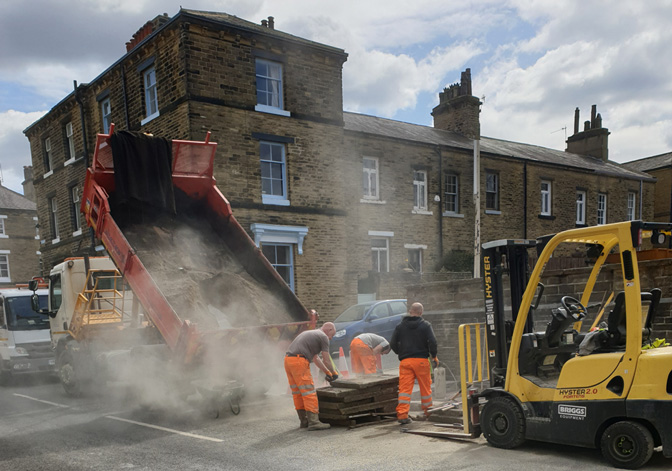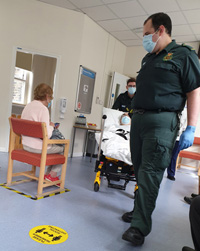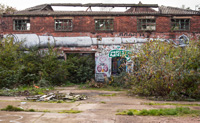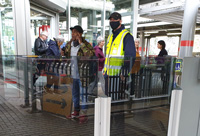
BIG DEAL New estimates jointly released jointly by two UN agencies that indicate work causes approaching two million deaths worldwide each year fall substantially short of the real toll, the global union confederation ITUC has warned. more
Lots of us have a compost heap in our gardens, but workers in industrial scale composting facilities come into contact with biological spores and other hazards at concentrations thousands of times higher and linked to occupational diseases including farmers’ lung, aspergillosis, occupational asthma, histoplasmosis and even Legionnaire’s disease.
While it may appear that staff in recycling centres are only dealing with our household waste, their regular contact with heavy metals may result in other wise rare cancers and allergies.
Noise is all around us, but for helicopter pilots in the North Sea, industrial workers or musicians, long term exposure to high noise levels is cause of debilitating hearing loss. The sound frequency and decibel levels cannot be recorded accurately without technical equipment such as a noise meter.

FALLING DOWN Construction workers are four times as likely as other workers to fall foul of a workplace fatality, but they are many times more likely to die from work-related health problems than ‘accidents’.
It’s the same with dust, something we’re all exposed to every day of our lives. Yet workers are often exposed to much higher levels than the general public and all day long, just because of the jobs they do. Long term respiratory illnesses appear in clusters wherever stone, wood, grain, coal, poultry or exhaust fumes are part of the work process.
It’s the continued exposure over long periods in the workplace that can cause irreparable damage. Decades after it was banned, asbestos continues to kill thousands of people in the UK every year and remains the single largest industrial killer. It appears in everything from insulation to window frames. Often there is no way of knowing for certain what the dust is or whether it is harmful.

LINGERING DEATH Long-banned asbestos remains in millions of buildings and continues to kill thousands in the UK each year. The global industry is using dirty tricks to push sales of the fatal fibre in Asia.
So even the most active safety reps sometimes require technical assistance in order to fully understand what is making the workers we represent unwell. Specialist equipment and laboratories that can measure tiny amounts of harmful substances are sometimes needed. Union safety reps are not expected to source this expertise themselves, instead the Safety Representatives and Safety Committee Regulations 1977 explicitly require employers to provide the facilities and assistance as may be necessary to fulfil our functions.
I know one nurse who is a safety rep in an NHS hospital who is supplied with a Geiger-counter to check radiation levels where mobile x-ray units are being used. So it’s hardly asking for the moon to get your employer to provide a thermometer or a light meter if temperature or inadequate lighting are safety concerns in your workplace.

PROBLEM MASKED Long before the pandemic, rail platform staff needed protection from diesel exhaust fumes from train engines, linked to lung and bladder cancer and serious respiratory diseases.
But even when calling on technical assistance, we should never view external experts as knights in shining armour who can be called in to solve our problems for us. A bottom-up response is always needed.
Workers who do the job are often best placed to know what is likely to be causing them harm in the first place. Anyone who has ever cut up hardwood for a living is likely to have suffered from an irritating cough or sinus problems. Long term, these exposures can lead to asthma or nose cancer.
The job of a union safety rep is not just to spot when a guard is removed from a machine or a safety system is bypassed. It is also about identifying occupational diseases – and that often starts by talking to workers about their coughs, rashes, health worries or aches and pains.
• What’s up? Try some union do-it-yourself health research.
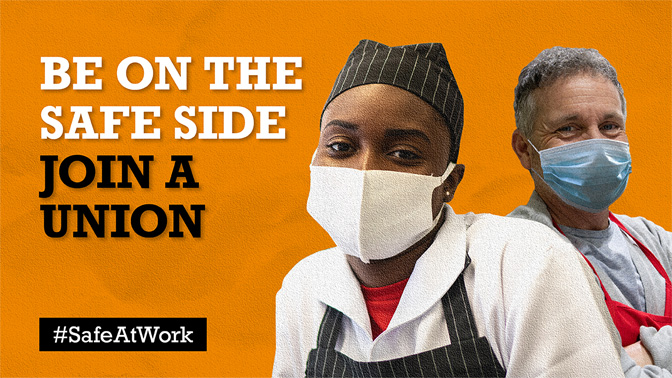
The figures were announced in September 2021 by the International Labour Organisation (ILO) and World Health Organisation (WHO). Their report considered just 19 workplace risk factors and found they were responsible for 1.9 million deaths. It estimated the greatest causes of work-related deaths were chronic obstructive pulmonary disease (450,000 deaths a year); stroke (400,000 deaths each year) and ischaemic heart disease (350,000 deaths). Occupational injuries caused 19 per cent of deaths (360,000 deaths). “It’s shocking to see so many people literally being killed by their jobs,” said Dr Tedros Adhanom Ghebreyesus, WHO director-general. “Our report is a wake-up call to countries and businesses to improve and protect the health and safety of workers by honouring their commitments to provide universal coverage of occupational health and safety services.” However, the international trade union confederation ITUC warned that adding in causes of death by risk factors not included in the joint report – including work-related psychosocial factors and infectious diseases – and filling in information gaps from poor record-keeping brings the real world total closer to three million deaths. ITUC said even that is likely to be an underestimate. ITUC deputy general secretary Owen Tudor said: “The mounting toll of deaths due to work will only be stopped by making occupational health and safety a fundamental right at work along with the other ILO Fundamental Rights – freedom of association, collective bargaining and freedom from discrimination, child labour and forced labour. This must be finalised at the annual ILO Conference next year, to spur stronger action by governments to prevent death and disease at work, in both the private and public sectors.” He backed the WHO call for universal access to occupational health services and called for other measures, including wider participation of workers and unions in all levels of health and safety. Tudor added: “We also look forward to the ILO and WHO completing the picture by capturing accidents and diseases that are not covered in their recent announcement, including the list contained in ILO Recommendation 194,” the official ILO List of Occupational Diseases. As well as psychosocial- and infection-related work deaths, many other well established and frequently fatal occupational diseases like silicosis are not included in the WHO/ILO calculations. Most work causes of cardiovascular diseases are also ignored, and many major recognised occupational cancers – like the ‘probable’ association the UN acknowledges between breast cancer and night work and cancers caused by pesticide exposures – are also absent.
|
Back to main story • Back to the top
NO ACCIDENT
The fact that occupational diseases are often caused by something seemingly innocuous and familiar in everyday life, means that hazards causing long term ill-health are often overlooked, warns union safety tutor David Smith. He says with most work-related harm caused by diseases not accidents, union health and safety reps need to remember the ‘health’ in their job title.
Also see
World of work: New deaths figures must spur action
Images
Click on images for larger versions

